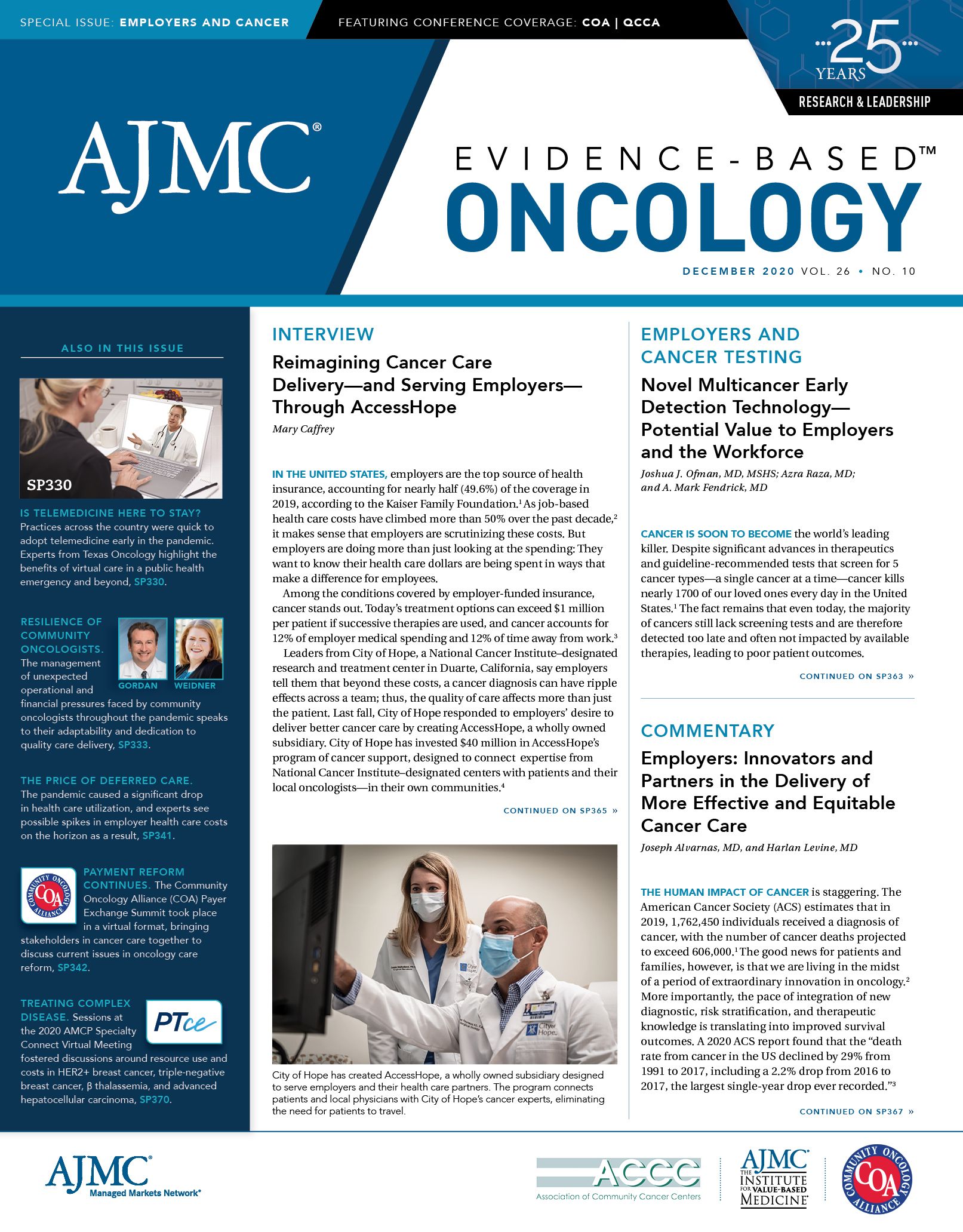Publication
Article
Evidence-Based Oncology
Pursuing a Different Triple Aim: Employers Seek Better Health Care, Improved Productivity, and Lower Costs
Author(s):
In this issue of Evidence-Based Oncology™, we explore the role of collaboration between employers and providers in reducing health care costs, improving workforce health and productivity, and improving health care.
https://doi.org/10.37765/ajmc.2020.88568
In this issue of Evidence-Based Oncology™, we explore the role of collaboration between employers and providers in fulfilling a different triple aim: the employer’s priorities as a health care purchaser, which are to:
- reduce health care costs
- improve workforce health and productivity
- improve health care
Steep increases in US health care costs are not sustainable, but this is not just because of the competitive disadvantage for employers competing in a global marketplace. Rising costs also result in lost productivity, financial toxicities, and poor outcomes. In the United States, our “Tale of Two Cites” in the health care system plays out in site-of-care differentials that are impossible to justify. The United States may be alone among the world’s developed countries where the cost of administering the same infusible drugs can vary by 150% within a 2-mile radius—with no difference in patient outcomes. Then there’s the cost of acquiring the drugs themselves. Acquisition costs can vary depending on the size of the health system and, more importantly, its monopoly over services in a region. Mergers and acquisitions can create market forces that result in substantial increases in drug costs, without any change in the infrastructure itself—just by changing the tax ID number of National Provider Identifier of the billing entity.
In situations where site of care is least relevant from a complexity-of-service perspective, regional business coalitions can, and should, explore more efficient, patient-centered care to help employers facilitate better, safer, and less expensive care. These regional business coalitions (an employer-led nonprofit organization ) can and have started playing an important role, with the mission of developing best practices for maintaining a healthy workforce. They ensure that when employees do need health care, that care is safe, high quality, and affordable—and achieved through partnerships and contracts with local and regional provider coalitions and clinically integrated networks.
As employer-led coalitions lead the way by providing umbrella organizations for small to medium—or even some large employers—it is important to identify best practices for keeping employees healthy and productive. These coalitions can represent collective bargaining power on behalf of their employers and employees to explore affordable access to health care with established quality standards. These principles are also aligned with concept of Value-Based Insurance Design, V-BID.
In oncology, the rise of biologics to treat cancer as a chronic disease provides unique opportunities for business groups on health to make a difference. Biologics off er the best opportunities for cost savings and improved access in the years ahead. While biologic products represent the minority of all prescriptions dispensed in the United States, they represent a large volume of total benefit spend. As the FDA approves more new biologic products, the share of total benefit spend grows as the number and claims cost of prescriptions increase. Generally, pharmacy benefit managers (PBM)s make recommendations for coverage of biologics.
Employers need to shift their focus; instead of ceding power to the PBMs, they can make changes to their own benefit plans. This includes checking contracts for policy language that selectively opt for more expensive drugs, instead of those that are less expensive but equally effective FDA-approved alternatives, such as biosimilars. They must audit PBM coverage recommendations, design biologic and biosimilar elements of coverage language in the vendor-contracting strategy, and determine if site of care strategy is beneficial to company prescribed by care setting. Finally, there must be a continuous communication strategy aimed at all plan members, so they understand their coverage.
The employers should scrutinize PBM recommendations and designs diligently to ensure that the recommendations for formularies are based on clinical efficacy—not rebates, discounts, exclusive contracts, or narrow networks. These recommendations should be based on clinical outcomes balanced with drug costs to maximize savings with the highest quality of care. These simple steps will help them achieve affordable access to care to their beneficiaries.
Kashyap Patel, MD, is associate editor of Evidence-Based Oncology.™ He is the CEO of Carolina Blood and Cancer Care Associates and the incoming president of the Community Oncology Alliance.





